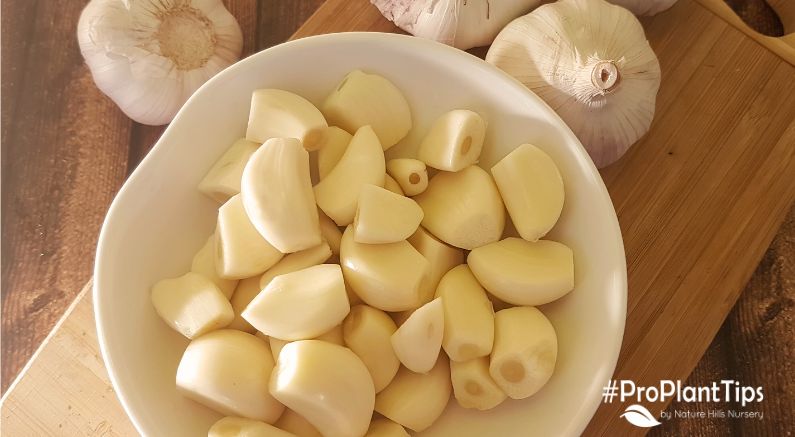Early Romans used Garlic as a spice and food, the Greeks offered Garlic bulbs as gifts to the gods, and Hippocrates used garlic to treat parasites, as a laxative, and as a diuretic. Widely used medicinally for its antibiotic and antiviral properties, Garlic was used to treat colds, fever, and diarrhea, saved hundreds of lives from the plague, and protected people from cholera, typhoid fever, and diphtheria.
Today, Garlic has shown it may lower cholesterol, blood sugar, and blood pressure, keep arteries flexible, and prevent blood clots and plaque buildup, reducing the risk of stroke.
Plus Garlic is a must-have for repelling vampires if that’s a problem in your area!
Check out how easy it is to grow your own flavorful Garlic harvest!

Planting Garlic Cloves
Much of the grocery store Garlic is grown in China and it has been treated to prevent sprouting. This means store-bought Garlic will not readily grow in your garden, so you won’t have much success.
Nature Hills offers quality Garlic Bulbs that have not been treated to prevent sprouting. In most areas, Garlic is planted in fall where it makes roots and then goes dormant. Once spring arrives, it will sprout very early and produce nice bulbs by harvest time in the summer.
In cooler climates, Garlic can be planted in the fall and harvested in early summer when the tops turn yellow. However, in warmer climates Garlic can be planted in the early spring. Plant these bulbs outdoors about six to eight weeks before the ground freezes in the fall if you are in a cooler growing zone, or the early spring if you are in a hot climate.
Garlic grows in a range of climates and soil types and it can be argued that the flavor and quality of your Garlic variety is determined by location, soil, and climate.

For best results, plant in full sun for the fastest growth and strongest stems, in a rich, well-drained soil location.
When planting Garlic, divide the dormant bulbs into separate cloves (called bulbils) and plant individually, root side down and pointed side up, with a small portion of the bulb poking above the soil, root side down. Space cloves 2 to 4 inches apart in rows 6 inches apart and cover with an inch or two of soil.
Provide moderate to low moisture as needed throughout the growing season with a layer of mulch or compost over the soil surface.
Types of Garlic
There are 11 distinct Garlic groups and two main categories - Hardneck and Softneck. Then there is Elephant Garlic, which is actually a kind of Leek.
Hardneck Garlic
Hardneck Garlic has a robust flavor and a central hard stalk that runs from roots to shoots and flowers. The large and easier-to-peel cloves are arranged around this stalk.
Hardneck is also best for colder climates and includes:
- Porcelain - Like Musik Porcelain Garlic
- Rocambole - Like Spanish Roja Hardneck Garlic
- Purple Stripe/Glazed Purple Stripe/Marble Purple Stripe - Like Duganski Purple Stripe
- Asiatic - Like Violet Spring Garlic
- Turban - Like Chinese Pink Garlic
- Creole - Like Purple Creole Garlic

Hardneck Garlic also produces scapes - the tender, curled stem and flower bud that can be harvested and used as mild Garlicky greens in cooking.
Softneck Garlic
Softneck Garlic is the typical type you’d see in the grocery store and usually has a milder flavor but a longer shelf life. Softneck Garlic is also best for warmer climates. Typically, the cloves are smaller than hardneck cloves.
Softneck varieties include
- Silverskin - Like Silver Rose Garlic
- Artichoke - Like Italian Late Garlic
- Middle Eastern
Enjoying and Harvesting Garlic
Garlic should be planted in the fall and harvested in early summer when the tops turn yellow or when the tops start to dry. Clean, and store in a cool, dry location with plenty of air circulation.
Get ready to learn how to braid Garlic and create unique gifts and kitchen decorations.
Happy Planting!


